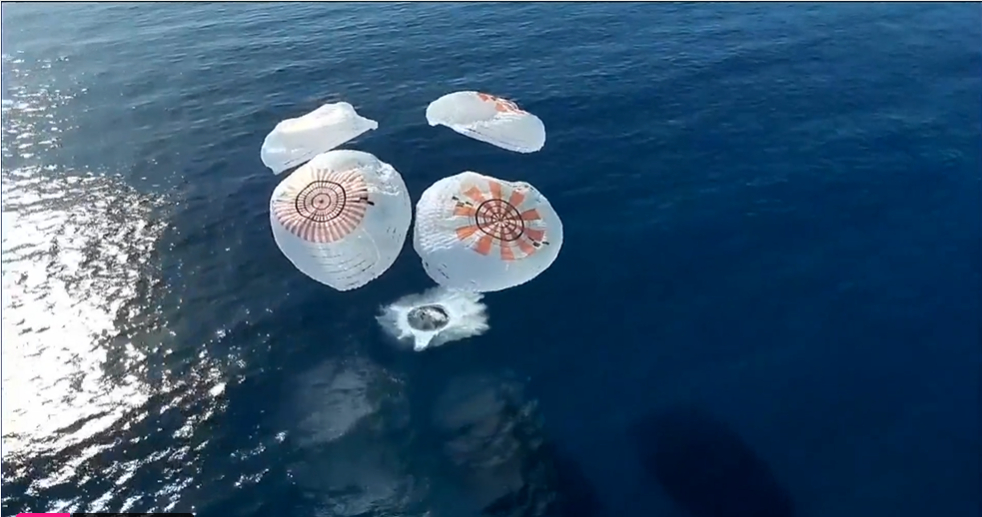SpaceX’s private Fram2 mission splashed down today (April 4) at 12:18 p.m. ET (1618 GMT), softly parachuting down into the Pacific Ocean, off the coast of Oceanside, California. Their return wraps up about three and half days spent in space, completing the first crewed mission to fly a polar orbit around Earth. “We have confirmation of splashdown of the Dragon spacecraft. Dragon has returned home with the Fram2 crew,” SpaceX officials said on the mission’s livestream.
Maltese cryptocurrency billionaire Chun Wang funded Fram2, and served as mission commander during his crew’s training and spaceflight. Chun is joined by fellow polar explorers Jannicke Mikkelsen of Norway, as designated Dragon commander; Rabea Rogge, from Germany, as mission pilot; and Australian Eric Philips as mission specialist and medical officer.

A SpaceX Falcon 9 rocket launched the quartet from NASA’s Kennedy Space Center in Florida on Monday, March 31, sending four spaceflight rookies into a north-to-south trajectory in low-Earth orbit at an altitude of about 271 miles (437 kilometers). From their novel perspective, the “Framonauts” were able to witness Earth’s poles like no astronauts ever have before, and spent the past three days documenting and sharing that view with the world.
@satofishi, 9:07 PM · Apr 3, 2025

@satofishi, 9:07 PM · Apr 3, 2025
“I often say Fram2 is a Svalbard mission. We @framonauts all met on Svalbard, and we love the ice. The mission was planned when I lived there, and we fly polar because, in an ISS-like orbit, we are unable to see where we live. From this perspective, the mission has perfectly achieved its goal.”
During their time in space, the Fram2 crew conducted a total of 22 science experiments aboard Resilience, including one that captured the first X-ray of a human in space. Another, called MushVroom, was aimed at studying how mushrooms grow in a microgravity environment.
Related: Watch chilling 1st views of Earth’s poles seen by SpaceX Fram2 astronauts (video)

The crew’s return also granted the opportunity for a number of post-flight experiments and observations. The final pieces of research are being conducted to investigate the Framonauts’ recovery following their time spent in microgravity. Upon landing, the crew has foregone the usual medical and mobility assistance utilized by astronauts following spaceflight, and will assess their own strength as their bodies reacclimate to gravity unaided.
SpaceX’s Dragon recovery ship Shannon intercepted Resilience following splashdown, where an onboard crane lifted the spacecraft onto the deck. After disembarking the Dragon, the crew will helicopter to shore, where they will begin an hour of balancing and coordination testing. Shortly after, the Fram2 astronauts will undergo brain imaging scans using a portable MRI machine. Then, after a restful night’s sleep, the crew will spend another two days dedicated to their on-orbit research using a high resolution bone scanner at NASA’s Johnson Space Center, in Houston.
All four @framonauts have safely exited Dragon unassistedApril 4, 2025
Fram2 is the 16th crewed mission SpaceX has recovered following successful spaceflights, and its 17 crewed mission overall — SpaceX’s Crew-10 mission for NASA is currently docked to the International Space Station and scheduled to return later this year.
Fram2 is also SpaceX’s first astronaut mission to land in the Pacific Ocean. Previous missions have all splashed down off the coats of Florida, but SpaceX has begun shifting those returns to the West Coast to minimize the chance of debris from Crew Dragon’s expendable trunk module surviving atmospheric reentry and damaging property or causing injury should pieces of the spacecraft crash back down to Earth.
Join our Space Forums to keep talking space on the latest missions, night sky and more! And if you have a news tip, correction or comment, let us know at: community@space.com.
More about private spaceflight
Discover more from Cave News Times
Subscribe to get the latest posts sent to your email.
































Discussion about this post